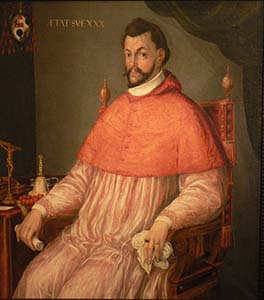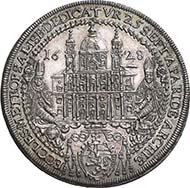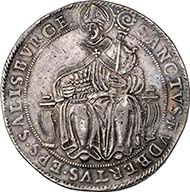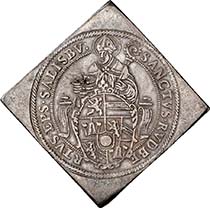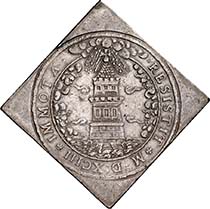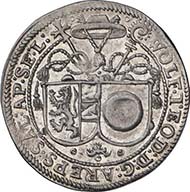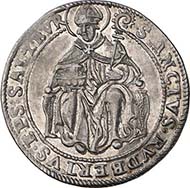2. Wolf Dietrich of Raitenau
In 1558, Helena, the sister of Cardinal and Bishop of Constance Marcus Sitticus of Hohenems, married Hans Werner III of Raitenau. On March 26th, 1559, at the Hofen Castle near Bregenz, she presented him with a son. He was christened ‘Wolf Dietrich’ and destined for a future in the Catholic Church.
Dietrich of Raitenau, portrait by Kaspar Memberger (c. 1555-1618)
Little Wolf Dietrich’s prospects were quite promising. He was, after all, the nephew of an influential cardinal on his mother’s side. Plus, he had a (future) saint amongst his relatives. Charles Borromeo, the – according to the views of the Counter-Reformation – exemplary Bishop of Milan was the brother of the sister-in-law of Wolf Dietrich’s mother Helena.
A clerical career
Actually, little Wolf Dietrich hoped to become condottiere, like his uncle and his father before him. But that dream he had to bury. Instead of learning the art of war, the boy was taught everything a bishop might need to know. In contrast to his uncle Marcus Sitticus, who came to his office as Bishop of Constance and its accompanying duties totally unprepared, Wolf Dietrich received a more than thorough instruction. After having been awarded his first benefices, i.e. his first income from a churchly means of living, at the tender age of 12 – it really paid off to have an influential relative sitting in the College of Cardinals – the 15-year-old went to Rome. For five years he studied at the Collegium Germanicum, the then most prestigious education institution for Catholic priests.
Wolf Dietrich must have been a talented and convincing cleric who the cathedral chapter trusted to successfully lead a diocese. Apart from that, he was closer related neither to the Bavarian court nor to the one of the House of Habsburg so that Salzburg, whose territory was sandwiched between these two great powers, need not be afraid of the covetous reach of his more powerful neighbours. Hence, on March 2nd, 1587, the cathedral chapter of Salzburg elected him the new bishop – not without having him contractually ensure as many rights as possible.
Marcus Sitticus the Elder, the uncle in the Vatican, had pulled the strings only in the background at the most. But when the newly minted bishop needed a dispensation for age, he used his drags: after all, according to the new churchly reformation right, Wolf Dietrich with his 28 years of age was too young to hold such a responsible office as bishop.
SALZBURG. Paris of Lodron, Prince Archbishop 1619-1653. Taler 1628 on the dedication of the new cathedral. Saints Rupert and Virgil with the church model. Rev. Translation of the relics. Dav. 3499. From auction sale Numismatik Lanz 127 (2005), 373.
Therewith, young Wolf Dietrich became master of one of the biggest and most important religious principalities in Germany – with Salzburg being a part of the empire until 1803. He was an energetic prince bishop and did everything that an absolutistic sovereign was supposed to do a century later. Without paying any attention to his contract, he diminished the importance of the cathedral chapter but promoted the economy, culture and – to the sorrow of his subjects – also the tax system. And he built as much as he could. 60 town houses were torn down to make room for the magnificent new cathedral that was only inaugurated under his successor Paris of Lodron (1619-1653).
The mint
The building cost a lot of money. The coins were supplied by the Salzburg Mint which was a subject to the administration of the archbishop under Wolf Dietrich. The lease system had already been abolished under his predecessor Johann Jakob Khuen (1560-1586).
The place of coin minting changed under Wolf Dietrich. He needed the place where the mint had been for the enlargement of his residency. The new mint was opened in the Getreidegasse 19 in 1605. There, the pieces continued to be minted with anvil and hammer. The roller minting was introduced later, under Paris of Lodron.
SALZBURG. Wolf Dietrich of Raitenau, Prince Bishop 1587-1612. Taler n.d. Crest of Wolf Dietrich under legate hat. Rev. Enthroned Saint Rupert. Dav. 8184. From auction sale Numismatik Lanz 127 (2005), 272.
The taler issued under Wolf Dietrich with their weight of c. 28.8 g and their fineness of 894/1000 correspond with the Imperial Mint Order of 1535.
Officially, the value of these taler was fixed to 68 kreuzer already in 1566. But that had nothing to do with reality even before Wolf Dietrich assumed office. In 1587, the moneychangers exchanged such taler for70 kreuzer; in 1608, they even reached an exchange rate of 84 kreuzer.
The Salzburg Mint was effective – in fact, it was that effective that the Bavarian dukes time and again asked for assistance. In 1596, for example, Maximilian I had a small number of ducats minted in the name of his father. In order to determine their fineness he had them sent to Salzburg.
Whereas the inner expansion of the diocese of Salzburg made good progress, he was not that fortunate when it came to foreign policy. Actually, he later tangled with his two powerful neighbours that much that nobody protested when he was deposited and arrested. The once so hopeful young bishop spent his last years in strict confinement at the Hohensalzburg Fortress.
The Turkish wars
The reason for the conflict with the House of Habsburg were the Turkish wars – the fact notwithstanding that Wolf Dietrich had actively supported the emperor at the beginning of his own reign. In those days, the Ottoman Empire tried to conquer entire Europe. The Balkans was completely occupied, the front line had moved to Hungary, but parts of Carinthia and Styria suffered from the attacks as well. The diocese of Salzburg owed some property there so that it might well be understood as self-protection when on October 28th, 1592, Wolf Dietrich sent 1.000 soldiers at his own expense and led by his uncle Jakob Hannibal I of Hohenems to the emperor as auxiliary troops for the Turkish wars. These soldiers returned a year later without having been involved in a single military action. Wolf Dietrich distributed gold coins and taler to the participants according to their rank. And he listened; to his uncle Jakob Hannibal and his father who died soon later due to the exertion he had endured during that pointless campaign. In unison, they reported about the army’s incredible disorganisation.
SALZBURG. Wolf Dietrich of Raitenau, Prince Bishop 1587-1612. Double taler klippe 1593. Rupert holding the crest of the Prince Bishop. Rev. RESISTIT IMMOTA (= Steady he may stand. Tower in storm-tossed sea, buffeted by the winds, hit by hail. Dav. 8198. From auction sale Numismatik Lanz 127 (2005), 258.
Contemporary sources connect the ‘tower in storm’ taler of 1593 with the reward Wolf Dietrich had earned for sending his troops against the Turks.
From then on, Wolf Dietrich fought the mismanagement in the Turkish war. What he had in mind was – a modern thought really – a clear concept but the way he called for it was so undiplomatic that, his noble and patriotic intentions notwithstanding, he alienated the emperor again and again. What commander-in-chief likes to be accused of incompetence – especially when it is true? Even though Wolf Dietrich supported his imperial policy for the most part, he continued to be an inconvenient Prince Bishop for the emperor.
Bavaria and Salzburg
In regard to neighbouring Bavaria, the inconstant policy of Wolf Dietrich proved unfavourably for Salzburg, too. At first, the bishop had benefited from the good relationship his predecessor had with the Bavarian duke – but that soon changed. When Maximilian I assumed the Bavarian autocracy in 1597, two obstinate power seekers were facing each other, no one willing to give in. The first big conflict broke out in 1608 when Wolf Dietrich refused to join the Catholic League initiated and led by Maximilian. The fight, however, was all about economic reasons.
SALZBURG. Wolf Dietrich of Raitenau, Prince Bishop 1587-1612. 1/8 taler (= half ortstaler) n.d. Shield of diocese and family. Rev. Legate hat. Enthroned Saint Rupert. Probszt 852. From auction sale Numismatik Lanz 127 (2005), 289.
Even though we know depictions of Saint Rupert from as early as the 12th century: only from the 15th and 16th centuries onward he is shown with his characteristic salt-measure, the attribute that allows a secure identification.
Salzburg – as the name already indicates – lived on the revenues of his salt mines. The Bavarian duke was doing the same. The big salt production facilities Reichenhall, Hallein and Berchtesgaden were distributed on both countries. Salzburg was at a disadvantage inasmuch as it was dependant on the Bavarian rivers to further transport the highly demanded good since Austria had strictly prohibited the transit of the Salzburg salt in 1566. In 1594, therefore, Wolf Dietrich and Maximilian made a contract by which Bavaria bound itself to the marketing of the salt – in return, it was granted a say in the salt prices. The contract stipulated the amount of salt Bavaria was obliged to take per day. Soon, though, the salt could not be sold profitably anymore because Austria exerted political pressure on the main customer Bohemia not to buy the Bavarian salt. The sale, therefore, became something of a problem for Maximilian. Since he was bound by the contract, he was expected to absorb the financial losses. But the Bavarian duke refused to do so. It was too great a fight to balance the Bavarian budget his predecessor had ruined. Maximilian, therefore, tried to undermine the contract with many small breaches.
Surely, a negotiation would still have been possible at that moment. But that was not Wolf Dietrich’s cup of tea. In the night from October 7th to 8th, 1611, he had the small town of Berchtesgaden occupied. The bishop, however, had bit off more that he could chew. He had 13.000 men at his disposal whereas Maximilian of Bavaria had 24.000 soldiers. That settled the matter. On October 22nd, 1611, the Bavarian troops marched into the diocese of Salzburg. Wolf Dietrich fled and Maximilian conquered the town three days later. After twelve days, the Bavarian soldiers had caught up the bishop on the run. Although Wolf Dietrich was then already on the grounds of the House of Habsburg, meaning that technically the Bavarian army was not allowed to catch him after all, the emperor did not do anything against his capture. The bishop of Salzburg had offended him simply too often. A problem arose: actually whose prisoner was Wolf Dietrich? The cathedral chapter, who had soon come to terms with the victor, sent a delegation to the pope who took over Wolf Dietrich as official papal prisoner in 1612. The day of reckoning had come. Emperor, Maximilian and cathedral chapter – they all reproached the defenseless man for every single political mistake he had made. Wolf Dietrich of Raitenau, however, continued to negotiate until the last moment. He managed to financially secure his family – indeed, prince bishops were allowed to have a family in those days. In return, he renounced his office on March 7th, 1612. The former Prince Bishop remained in strict confinement at the Hohensalzberg Fortress until he died in 1617.
Oh yes, a short additional remark about Wolf Dietrich and his family: leading churchly circles expected then, in the late 16th century, the prohibition of marriage for Catholic clerics to be abolished to steal the Protestants’ thunder. Hence, Wolf Dietrich did not regard it a sin to live with Salome Alt, daughter of a Salzburg alderman, under one roof in some sort of marriage. His devoted companion presented him with 15 children. Salome Alt, who was elevated to the ranks of Imperial Nobility by the Holy Roman Emperor Rudolf II in 1609, outlived her “husband”. She died in June 1633 in exile in the Upper Austrian town of Wels.




